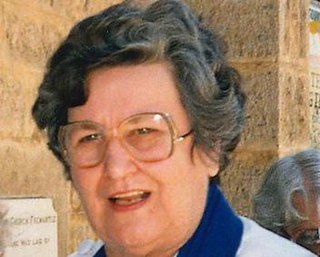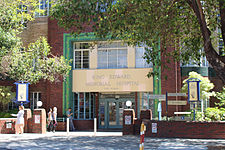
A home birth is a birth that takes place in a residence rather than in a hospital or a birthing center. They may be attended by a midwife, or lay attendant with experience in managing home births. Home birth was, until the advent of modern medicine, the de facto method of delivery. The term was coined in the middle of the 19th century as births began to take place in hospitals.

Edith Dircksey Cowan was an Australian social reformer who worked for the rights and welfare of women and children. She is best known as the first Australian woman to serve as a member of parliament. Cowan has been featured on the reverse of Australia's 50-dollar note since 1995.

Sir Charles Gairdner Hospital (SCGH) is a teaching hospital in Nedlands, Western Australia.
Mercy Hospital for Women, is based in Heidelberg adjacent to the Austin Hospital. The hospital offers obstetric, gynaecological and neonatal services and has one of only four neonatal intensive care units in Victoria. The Neonatal Intensive Care Unit is co-located with the Special Care Nursery and collectively they care for some of Victoria's most unwell babies. The hospital was opened in 1934.

Princess Margaret Hospital for Children (PMH) is a former children's hospital and centre for paediatric research and care located in Perth, Western Australia. It was the state's only specialist children's hospital until it closed in 2018, coinciding with the opening of the new Perth Children's Hospital that was built to replace it. Together with the Child and Adolescent Community Health Division, it made up the Child and Adolescent Health Service.

NETS is an acronym for newborn emergency transport service orsystem. Such services provide critical care transport for newborn babies requiring care not available in the hospital of birth. Some provide other services; such as outreach education, return transport and coordination of high-risk obstetric transfer. Others provide transport services in older age-groups.

Tsan Yuk Hospital, located on 30 Hospital Road, Sai Ying Pun on Hong Kong Island, is a public hospital in Hong Kong specialising in obstetrics and gynaecology. It also operates as a teaching and training hospital for the medical and nursing students of Li Ka Shing Faculty of Medicine of the University of Hong Kong.
The Zambia Electronic Perinatal Record System (ZEPRS) is an Electronic Medical Record (EMR) system used by public obstetric clinics and a hospital in Lusaka, Zambia.

St Michael's Hospital is a hospital in Bristol, England. Built in 1975, it provides maternity services for Bristol. The hospital is managed by University Hospitals Bristol and Weston NHS Foundation Trust.
The Canadian Perinatal Network (CPN) is made up of Canadian researchers who collaborate on research issues relating to perinatal care. The network commenced in September 2005, and includes members from 25 tertiary perinatal units. CPN will enable health care professionals, researchers, and administrators to participate actively in clinical, epidemiologic, health services, health policy, and informatics research aimed at improving the effectiveness and efficiency of perinatal care.

St John of God Murdoch Hospital is a 511-bed private non-profit hospital located in the southern suburbs of Perth in Western Australia, immediately adjacent to the public Fiona Stanley Hospital campus. The distance between the entrances to the emergency departments of these two hospitals is approximately 390 m (427 yd).
Obstetrical nursing, also called perinatal nursing, is a nursing specialty that works with patients who are attempting to become pregnant, are currently pregnant, or have recently delivered. Obstetrical nurses help provide prenatal care and testing, care of patients experiencing pregnancy complications, care during labor and delivery, and care of patients following delivery. Obstetrical nurses work closely with obstetricians, midwives, and nurse practitioners. They also provide supervision of patient care technicians and surgical technologists.

St John of God Subiaco Hospital is a private hospital in Subiaco, Western Australia, founded in 1898.
St John of God Ballarat Hospital provides hospital care for people living in Ballarat and Western Victoria regions of Australia.
St John of God Bendigo Hospital is a 167-bed private hospital located in central Victoria.

Agnes Marion McLean Walsh was head matron of King Edward Memorial Hospital, a Western Australian maternity hospital from 1922 until her retirement in December 1954, during which time more than 60,000 babies were born under her supervision. In that capacity she advised the Commonwealth Government on midwifery policy and was on the National Medical Research Council.
Doris Clifton Gordon was a New Zealand doctor, university lecturer, obstetrician and women's health reformer. She was known as 'Dr Doris', famous for her work in rural general practice, for raising the status of obstetrics, improving obstetrics education of medical students and doctors, and working for the welfare of mothers and children.

St John of God Midland Public and Private Hospitals is a health care facility in Midland, Western Australia which opened in November 2015.

Beryl Grant was an Australian nurse, community worker, and public servant.

Charles Richard Whitfield FRCOG, FRCP(G) was a Northern Irish obstetrician and gynaecologist who was a pioneer of maternal-fetal (perinatal) medicine. His primary interest was in fetal medicine, a branch of obstetrics and gynaecology that focuses on the assessment of the development, growth and health of the baby in the womb. He was also an early proponent of subspecialisation within the fields of obstetrics and gynaecology, a practice that is common today.
















